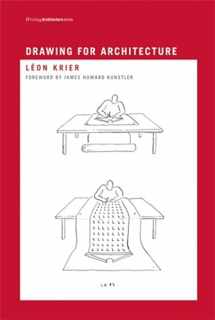
Drawing for Architecture (Writing Architecture)
Book details
Summary
Description
Drawings, doodles, and ideograms argue with ferocity and wit for traditional urbanism and architecture.
Architect Léon Krier's doodles, drawings, and ideograms make arguments in images, without the circumlocutions of prose. Drawn with wit and grace, these clever sketches do not try to please or flatter the architectural establishment. Rather, they make an impassioned argument against what Krier sees as the unquestioned doctrines and unacknowledged absurdities of contemporary architecture. Thus he shows us a building bearing a suspicious resemblance to Norman Foster's famous London “gherkin” as an example of “priapus hubris” (threatened by detumescence and “priapus nemesis”); he charts “Random Uniformity” (“fake simplicity”) and “Uniform Randomness” (“fake complexity”); he draws bloated “bulimic” and disproportionately scrawny “anorexic” columns flanking a graceful “classical” one; and he compares “private virtue” (modernist architects' homes and offices) to “public vice” (modernist architects' “creations”). Krier wants these witty images to be tools for re-founding traditional urbanism and architecture. He argues for mixed-use cities, of “architectural speech” rather than “architectural stutter,” and pointedly plots the man-vehicle-landneed ratio of “sub-urban man” versus that of a city dweller. In an age of energy crisis, he writes (and his drawings show), we “build in the wrong places, in the wrong patterns, materials, densities, and heights, and for the wrong number of dwellers”; a return to traditional architectures and building and settlement techniques can be the means of ecological reconstruction. Each of Krier's provocative and entertaining images is worth more than a thousand words of theoretical abstraction.


We would LOVE it if you could help us and other readers by reviewing the book
Book review





